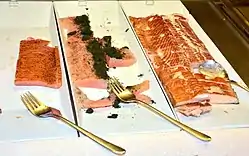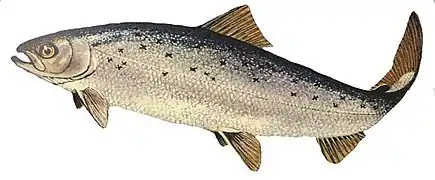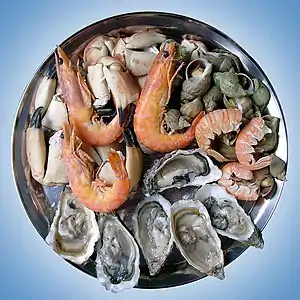Gravlax
Gravlax or grav(ad)laks is a Nordic dish consisting of salmon that is cured using salt, sugar, and dill. Gravlax is usually served as an appetizer, sliced thinly and accompanied by hovmästarsås (literally "maitre d'hôtel sauce", also known in Sweden as gravlaxsås, in Norway as sennepssaus, literally “mustard sauce”, and in Denmark as rævesovs, literally "fox sauce"), a dill and mustard sauce, either on bread or with boiled potatoes.
 Salmon dishes: gravlax in the middle, cold-smoked on the left and warm-smoked on the right | |
| Alternative names | Gravad lax, grav(ad)laks, gravad laks |
|---|---|
| Course | Hors d'oeuvre |
| Place of origin | Nordic countries |
| Main ingredients | salmon, salt, sugar, dill |

Etymology
The word gravlax comes from the Scandinavian word gräva/grave ("to dig"; modern sense "to cure (fish)") which goes back to the Proto-Germanic *grabą, *grabō ("hole in the ground; ditch, trench; grave") and the Indo-European root *ghrebh- "to dig, to scratch, to scrape",[1] and lax/laks, "salmon".
History
During the Middle Ages, gravlax was made by fishermen, who salted the salmon and lightly fermented it by burying it in the sand above the high-tide line.
Fermentation is no longer used in the production process. Instead the salmon is "buried" in a dry marinade of salt, sugar, and dill, and cured for between twelve hours and a few days. As the salmon cures, by the action of osmosis, the moisture turns the dry cure into a highly concentrated brine, which can be used in Scandinavian cooking as part of a sauce.[2] This same method of curing can be employed for any fatty fish, but salmon is the most commonly used.
See also
- Cured fish
- Carpaccio
- Gwamegi – Korean dried fish preparation
- Hákarl – A national dish of Iceland consisting of fermented shark
- List of hors d'oeuvre – Wikipedia list article
- List of raw fish dishes – Wikipedia list article
- Lox
- Rakfisk – Norwegian fermented fish dish made from trout or char
- Sashimi – Japanese dish
- Surströmming – A lightly-salted fermented Baltic Sea herring
References
- Svenska Akademiens ordbok, "grav Archived 2016-04-20 at the Wayback Machine", column G851; "grava column G868; and [http://dictionary.reference.com/browse/grave
- Ruhlman & Polcyn 2005, pp. 51–52.
Bibliography
- Ruhlman, M.; Polcyn, B. (2005), Charcuterie, New York: W.W. Norton & Company.
External links
| Look up gravlax in Wiktionary, the free dictionary. |
| Wikibooks Cookbook has a recipe/module on |
| Wikimedia Commons has media related to Gravad lax. |
- Gravlax Video.
- Gravlax Cured With Beetroot Video
- Cooking For Engineers: Gravlax – recipe with step-by-step pictures

